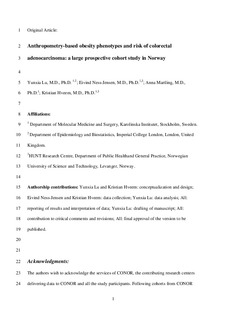| dc.description.abstract | Background: It is unclear whether obesity phenotypes measured by different anthropometric indices are associated with a risk of colorectal adenocarcinoma by anatomical location.
Methods: We compiled harmonized population-based cohort studies (Cohort of Norway, CONOR) with 143,477 participants that were conducted between 1994 and 2010. General, abdominal, and gluteofemoral obesity were assessed by body mass index (BMI, kg/m2), waist circumference (cm), and hip circumference (cm). Other measures examined were waist to hip ratio, waist to height ratio, and body adiposity index. We performed Cox proportional hazards regression to estimate hazard ratios (HRs) and 95% confidence intervals (CIs) of obesity relative to a risk of colorectal adenocarcinoma.
Results: In total, 2,044 incident cases of colorectal adenocarcinoma were identified. We observed a positive association between waist circumference (high versus low) and adenocarcinoma in the proximal colon (HR = 1.9, 95% CI = 1.5, 2.5) and distal colon (HR = 1.7, 95% CI = 1.3, 2.3) when adjusted for BMI. The association with waist circumference was especially strong in men. BMI was not associated with adenocarcinoma in the colon or rectum after adjusting for waist circumference. We found no association between hip circumference and colorectal adenocarcinoma. When adjusted for BMI plus waist circumference, body adiposity index was negatively associated with adenocarcinoma in the proximal or distal colon.
Conclusion: Abdominal obesity, but not general or gluteofemoral obesity, was associated with an increased risk of adenocarcinoma in the proximal and the distal colon, especially in men. Muscularity may be negatively associated with risk of colon adenocarcinoma. | nb_NO |
